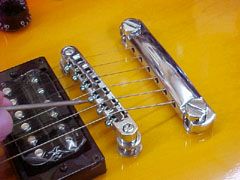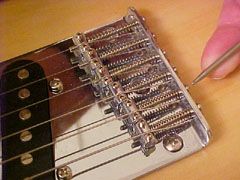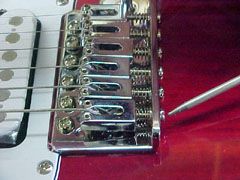Back in January, I wrote an entry about the vibrato tremolo. One of the things many guitarists overlook when they purchase a guitar, is how easy it is to adjust the intonation. In fact, in my experience, I have found that many guitarists don’t even know what those adjustment screws are for on the bridge.
What I hope to do here, is explain what intonation is and why it’s important to guitarists. At the end, I’ll have some links to some sites that provide really good information on how to set your intonation.
 One of the first things you should look at on the bridge of any guitar you may want to buy – regardless of whether or not it’s a stop tail or tremolo bridge – is how easy it is to adjust the intonation. If you can adjust it at all.
One of the first things you should look at on the bridge of any guitar you may want to buy – regardless of whether or not it’s a stop tail or tremolo bridge – is how easy it is to adjust the intonation. If you can adjust it at all.There are bridges out there that don’t allow for any change in intonation. It’s common on the wrap-around style stop-tail bridge. Some string-through-body electrics fail to use a bridge with a adjustable saddles.
Adjustments in the bridge cause the saddles, the point where the string passes over a tension point, to move forward or back. This raises or lowers the string slightly causing minor changes in pitch. The more the saddle can be moved forward or back, the greater control you have over the pitch.
 In my experience, on the most adjustable bridges, in terms of intonation, is the Fender Telecaster style bridge. Those long screws have a very good range. This is one of the reasons the Telecaster has been one of the most sought after electric guitars in history. It’s unique sound is due, in part, to it’s bridge.
In my experience, on the most adjustable bridges, in terms of intonation, is the Fender Telecaster style bridge. Those long screws have a very good range. This is one of the reasons the Telecaster has been one of the most sought after electric guitars in history. It’s unique sound is due, in part, to it’s bridge. The Telecaster’s sister guitar, The Stratocaster, is another guitar with a good degree of intonation adjustment and easy access. The Stratocaster’s floating tremolo was the first of its kind and exists today almost exactly as it was first introduced. The ease with which one can set up, modify and use the bridge is a testament to Leo Fender’s genius.
The Telecaster’s sister guitar, The Stratocaster, is another guitar with a good degree of intonation adjustment and easy access. The Stratocaster’s floating tremolo was the first of its kind and exists today almost exactly as it was first introduced. The ease with which one can set up, modify and use the bridge is a testament to Leo Fender’s genius. Again, many people seek out the Stratocaster (or Strat copies) for their sound. A combination of pickups and the bridge produce that thick, buzzy tone common on a huge chunk of Rock and Roll.
So, the question you’re probably asking yourself, if you’ve read this far, is, “Why the heck is this so important?”
Have you ever picked up a nice looking guitar, tuned it up, strummed a nice big G chord and it sounded awful? Even though you just tuned it? You might even go back and double check your tuning. It’s still on, but the strings just don’t seem to sound right when played together.
How about when you’re playing notes on a string and it sound great open, it sounds great for the first five frets, but suddenly it starts going sharp or flat the further you go up the fret board?
These are both issues with intonation. Your guitar can be in tune but the intonation ensures that it keeps its tuning as you fret the strings. Now, most of the time, if you use the same gauge strings all the time, and your guitar was set up when you bought it, your intonation stays set. Any changes tend to be so slight that you really can’t hear them. But I know you and you know me and guitarist like to mess with crap. We’re not content to just play our guitars and occasionally change strings. We have to mess with the bridge and get inside and see the guts of the thing. Well, somewhere along this road, you probably screwed up your intonation.
The good news is that if you have a good bridge, it’s pretty doggone easy to readjust. The bad news is that it usually takes a lot of time. To check and adjust your intonation, you’ll need a tuner, a tool to make the adjustments and one-and-a-half cups of patience.
First, tune your guitar. I’m going to assume that you tune standard so when I say “open low E string” or “open high E string,” I’ll be talking about the string and the key. If you use non-standard tuning, just convert the key as necessary.
Once you’re in tune, you can begin checking your strings’ intonation. I start at the high E string. Pluck it open and make sure it’s still in tune. Then fret the string at the 12th fret and make sure the tuner reads it as E and is not sharp or flat. If it’s sharp or flat, you need to adjust the intonation. To fix a flat, you have to increase the string tension. You do this by moving the saddle further away from the neck. To fix sharp, move the saddle closer to the neck.
When making adjustments, it’s important to make very small turns of the screw. Quarter turns are what I use. Then you must retune the string and then check the intonation again.
After you get your open string key intoned with the octave (12th fret) I also suggest you check the intonation of the natural harmonic at the 12th fret and the fretted note. They should be identical. If the harmonic is sharp or flat to the fretted note, then your intonation is still off.
You can see how this is a time-consuming process. But, if you want the best sound you can get, it really should be done. And, once you get it set, if you use the same string gauge, your intonation will most likely stay set between string changes.
Good tunin’ axe grinders!
Resources:
Project Guitar’s article on setting intonation. This is also a good resource for a lot of guitar-related information.
Fret Not Guitar Repair: A very good article about intonation that makes my layman’s term article look like a fifth grader’s paper.
Access Rock: A very basic guide to stringing and setting guitar intonation.




No comments:
Post a Comment